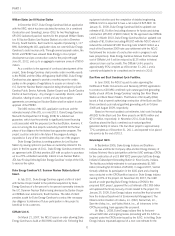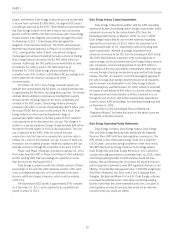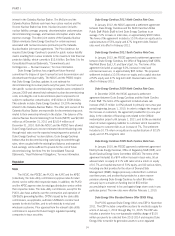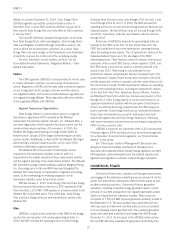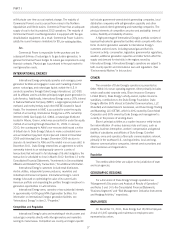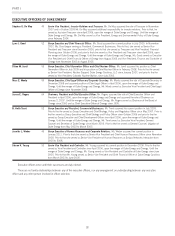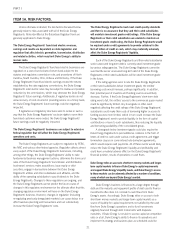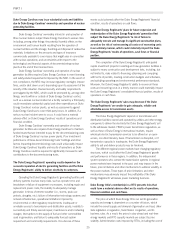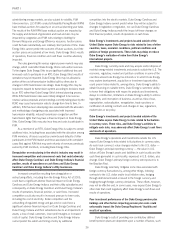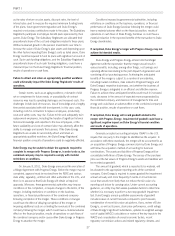Duke Energy 2011 Annual Report Download - page 37
Download and view the complete annual report
Please find page 37 of the 2011 Duke Energy annual report below. You can navigate through the pages in the report by either clicking on the pages listed below, or by using the keyword search tool below to find specific information within the annual report.
PART I
will fluctuate over time as coal markets change. The majority of
Commercial Power’s coal is sourced from mines in the Northern
Appalachian and Illinois basins. Commercial Power has an adequate
supply of coal to fuel its projected 2012 operations. The majority of
Commercial Power’s coal-fired generation is equipped with flue gas
desulfurization equipment. As a result, Commercial Power is able to
satisfy the current emission limitations for SO2for existing facilities.
Gas.
Commercial Power is responsible for the purchase and the
subsequent delivery of natural gas to its gas turbine generators. In
general Commercial Power hedges its natural gas requirements using
financial contracts. Physical gas is purchased in the spot market to
meet generation needs.
INTERNATIONAL ENERGY
International Energy principally operates and manages power
generation facilities and engages in sales and marketing of electric
power, natural gas, and natural gas liquids outside the U.S. It
conducts operations through Duke Energy International, LLC (DEI)
and its affiliates and its activities principally target power generation in
Latin America. Additionally, International Energy owns a 25% interest
in National Methanol Company (NMC), a large regional producer of
methanol and methyl tertiary butyl ether (MTBE) located in Saudi
Arabia. The investment in NMC is accounted for under the equity
method of accounting. International Energy has a 25% ownership
interest in Attiki Gas Supply S.A. (Attiki), a natural gas distributor
located in Athens, Greece, which was accounted for under the equity
method of accounting through December 31, 2009. In January
2010, the counterparty to Attiki’s non-recourse debt issued a notice
of default due to Duke Energy’s failure to make a scheduled semi-
annual installment payment of principal and interest in November
2009 and following Duke Energy’s December 2009 decision to
abandon its investment in Attiki andtherelatednon-recoursedebt.In
December 2011, Duke Energy entered into an agreement to sell its
ownership interest to an existing equity owner in a series of
transactions that will result in full discharge of its debt obligation; the
transaction is scheduled to close in March 2012. See Note 13 to the
Consolidated Financial Statements, “Investments in Unconsolidated
Affiliates and Related Party Transactions,” for additional information.
International Energy’s customers include retail distributors,
electric utilities, independent power producers, marketers and
industrial/commercial companies. International Energy’s current
strategy is focused on optimizing the value of its current Latin
American portfolio and expanding the portfolio through investment in
generation opportunities in Latin America.
International Energy owns, operates or has substantial interests
in approximately 4,600 gross MW of generation facilities. For
information on International Energy’s generation facilities, see
“International Energy” in Item 2, “Properties”
Competition and Regulation
International Energy’s sales and marketing of electric power and
natural gas competes directly with other generators and marketers
serving its market areas. Competitors are country and region-specific
but include government-owned electric generating companies, local
distribution companies with self-generation capability and other
privately-owned electric generating and marketing companies. The
principal elements of competition are price and availability, terms of
service, flexibility and reliability of service.
A high percentage of International Energy’s portfolio consists of
baseload hydroelectric generation facilities which compete with other
forms of electric generation available to International Energy’s
customers and end-users, including natural gas and fuel oils.
Economic activity, conservation, legislation, governmental regulations,
weather, additional generation capacities and other factors affect the
supply and demand for electricity in the regions served by
International Energy. International Energy’s operations are subject to
both country-specific and international laws and regulations. (See
“Environmental Matters” in this section.)
OTHER
The remainder of Duke Energy’s operations is presented as
Other. While it is not an operating segment, Other primarily includes
certain unallocated corporate costs, Bison Insurance Company
Limited (Bison), Duke Energy’s wholly-owned, captive insurance
subsidiary, contributions to the Duke Energy Foundation, Duke
Energy’s effective 50% interest in DukeNet Communications, LLC
(DukeNet) and related telecom businesses, and Duke Energy Trading
and Marketing, LLC (DETM), which is 40% owned by Exxon Mobil
Corporation and 60% owned by Duke Energy and management is
currently in the process of winding down.
Bison’s principal activities as a captive insurance entity include
the indemnification of various business risks and losses, such as
property, business interruption, workers’ compensation and general
liability of subsidiaries and affiliates of Duke Energy. DukeNet
develops, owns and operates a fiber optic communications network,
primarily in the southeast U.S., serving wireless, local and long-
distance communications companies, internet service providers and
other businesses and organizations.
Regulation
The entities within Other are subject to the jurisdiction of state
and local agencies.
GEOGRAPHIC REGIONS
For a discussion of Duke Energy’s foreign operations see
“Management’s Discussion and Analysis of Results of Operations”
and Notes 3 and 14 to the Consolidated Financial Statements,
“Business Segments” and “Risk Management, Derivative Instruments
and Hedging Activities,” respectively.
EMPLOYEES
On December 31, 2011, Duke Energy had 18,249 employees.
A total of 4,445 operating and maintenance employees were
represented by unions.
17



